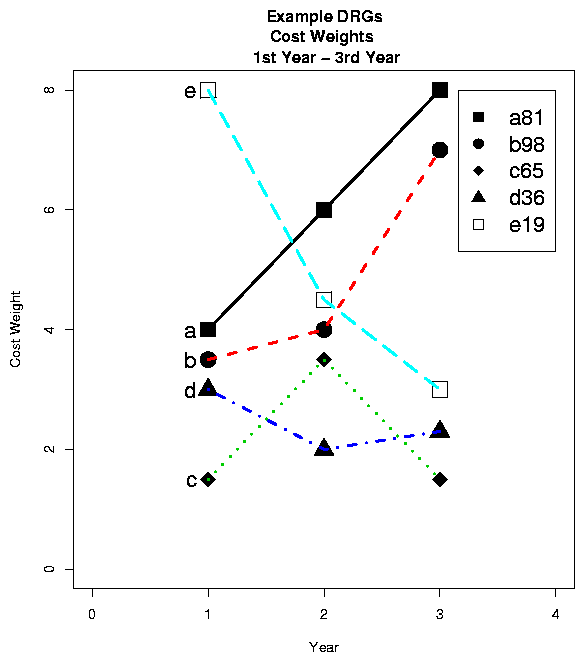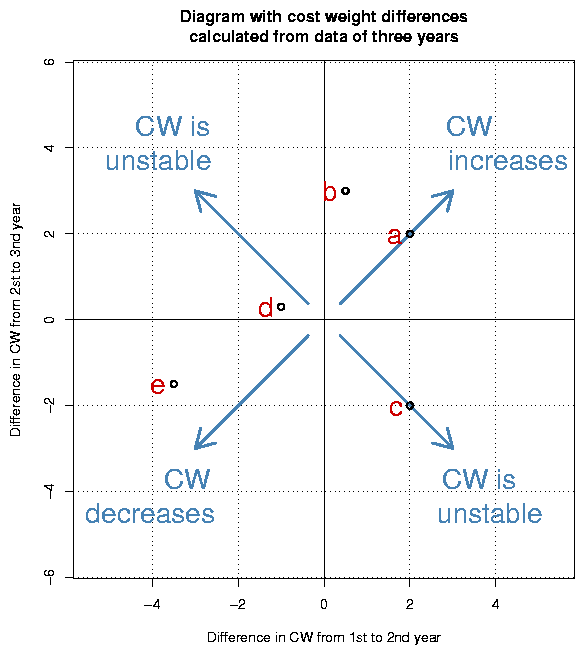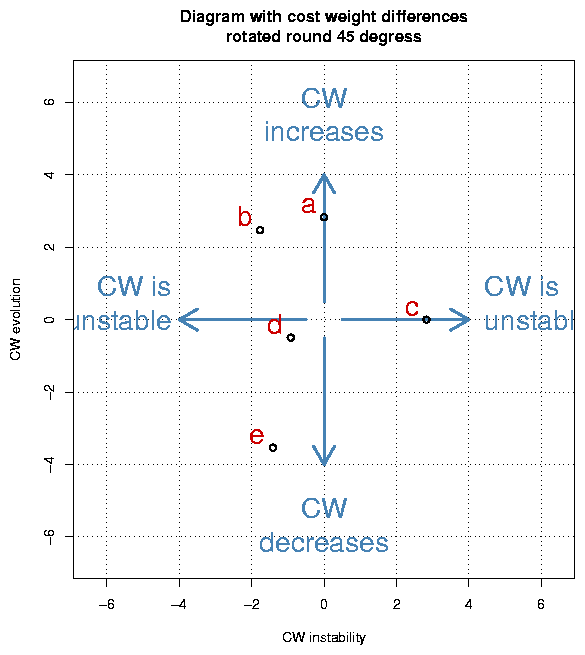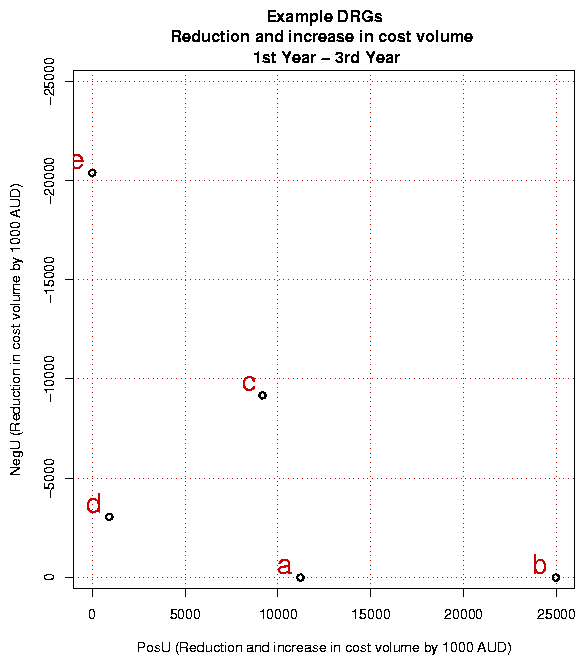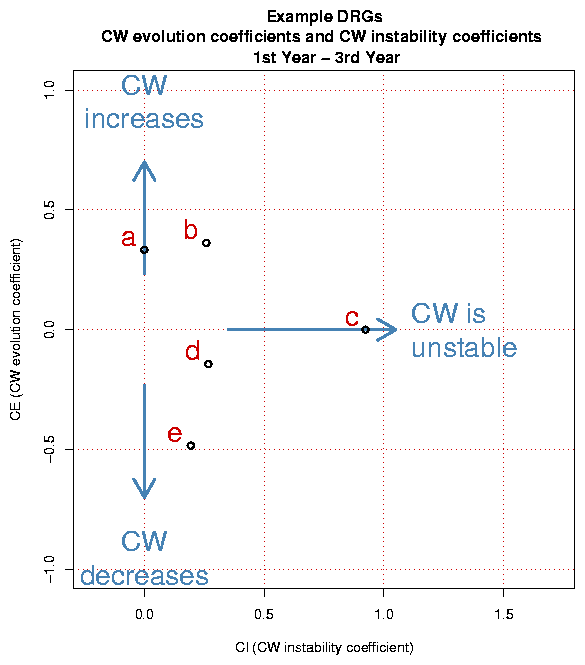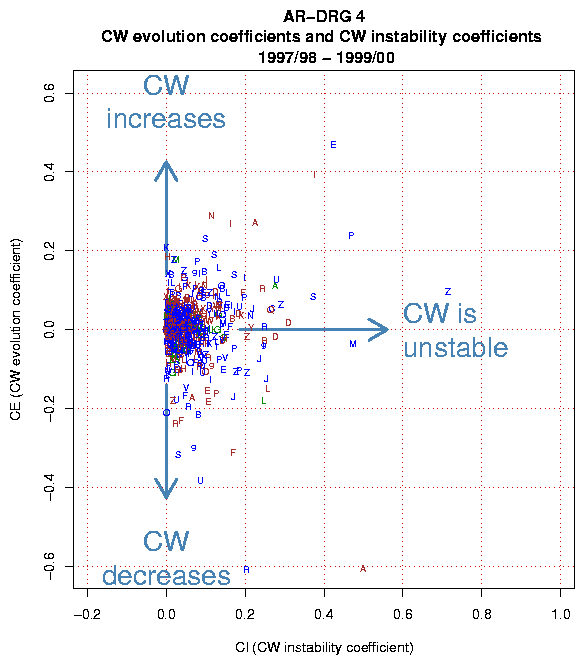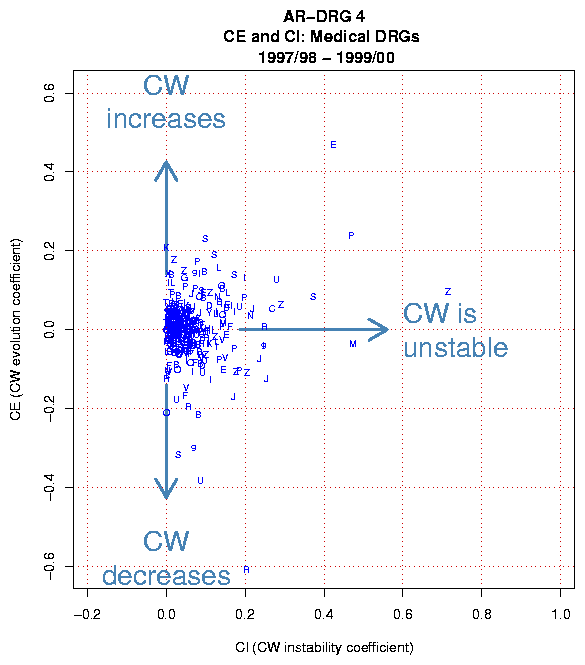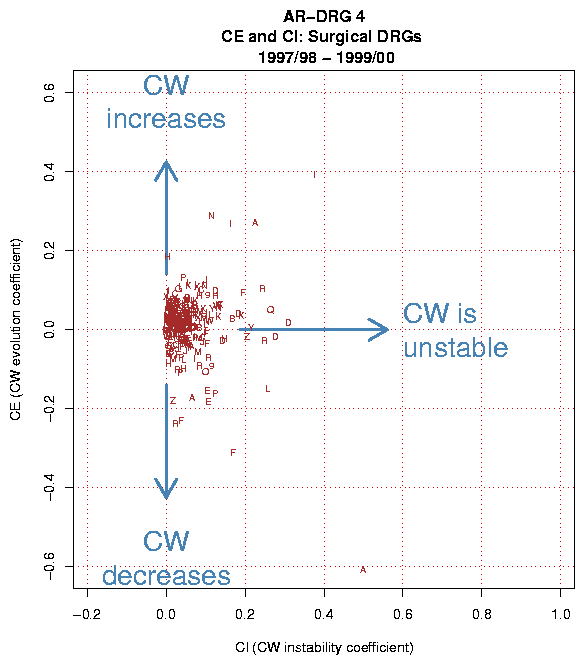|^·<×>·v| |
1 |
ABSTRACT
|
|
INTRODUCTION |
In this study, we present indicators to evaluate
the evolution and the instability of cost weights (CWs).
They are applied to the Australian national cost data. |
|
MATERIAL |
We used the national hospital cost data collections
of Australia from the years 1997/1998, 1998/1999 and
1999/2000 which were available on the internet. |
|
METHODS |
We defined coefficients for the analysis of the instability
and evolution of CWs. As a third figure, the average change
of the cost volume in Australian dollars is used. |
|
RESULTS |
From 1998/1999 to 1999/2000, the Australian cost volume
belonging to AR-DRGs with increasing costs had risen by
AUD +294 million, and the cost volume belonging to DRGs
with decreasing costs had decreased by AUD -205 million.
This corresponds to 3.2 %, and –2.2 %, respectively, of the
total of the cost volume which amounted to AUD 9,244 million.
We found 53 unstable AR-DRGs with an average yearly change of
CW which amounted to more than 15 %. The CWs of another 14 AR-DRGs
have risen every year by an average of more than 15 %; the CWs of
21 AR-DRGs sank more than 15 % in the yearly average.
With 36 unstable AR-DRGs, the average sum of the cost differences
was more than AUD 2.5 million per DRG. With another 44 AR-DRG
the reduction of the cost volume over two years was more than
AUD -2.5 million.
And the cost volume of 52 AR-DRGs rose by more than AUD 2.5 million. |
|
DISCUSSION |
To discover possible reasons for those striking variations of CWs,
we made lists with several questions not yet answered. It will be
necessary to do research into the environmental conditions (more
outpatient treatment, medical innovation), into the methodological
aspects (changes in the number of patients of the samples, small
numbers of patients per DRG, methods of the cost calculation), and
also into the DRG system itself (changes in the coding or grouping
systems, lack of clinical homogeneity of DRGs,
imprecise case definitions). |
|
CONCLUSIONS |
The results of this study point out that it can be difficult
to get stable cost weights over several years for DRGs which are
not homogeneous from the economic and/or the clinical perspective.
According to the causes of the variations of cost weights,
different approaches will be necessary to obtain solutions:
changes in the conditions which are set by the contractors,
changes in the processes within hospitals,
and changes in the design of the DRG system in use. |
|
|
|
|^·<×>·v| |
2 |
Introduction
|
1
Vgl. Fischer [DRG-Systeme, 2000]: 134-137
und Fischer [APDRG-LEP, 2001].
|
How stable are cost weights? |
The question as to the cost-related homogeneity of DRGs1
also raises the question as to the stability of cost weight calculations.
If cost weights (CWs) are exposed to arbitrary change over the years,
this will increase the financial risks of the contractors
who fix prices on this basis.
The risk for smaller hospitals will grow
since the amount of numbers of cases
is often inversely proportionate
to the effectiveness of statistical balance. |
2
Fischer et al. [CW-AR4, 2002].
|
About this text |
This text presents characteristic figures
for the assessment of the evolution
and instability of cost weights
on the basis of the national cost data of Australia.
It is based on a detailed study,
which the authors presented to the 3rd German Casemix Conference
in March 2002.2 |
|
|
|
|^·<×>·v| |
3 |
Material
|
3
National Hospital Cost Data Collection:
http:// www.health.gov.au / casemix / costing / costmain1.htm.
|
|
The study is based on the overall Australian cost data, which
are available on the Internet and refer to surveys conducted
for 1997/98, 1998/99 and 1998/99.3
From among
these data, the authors use the cost weights and the number of
cases per DRG and year.
The present cost weights are relative average case costs
of about 75 % of public hospitals. |
|
|
|
|^·<×>·v| |
4 |
Method
|
|
Example data |
To explain the method that was developed,
the authors generated an exemplary data set.
[Tables 1 and 2] |
Table 1:
Beispiel-DRGs |
| DRG
| a
| b
| c
| d
| e
|
| DRG-code
| a81
| b98
| c65
| d36
| e19
|
| Label
| Constant increase of CW
| Reinforcing increase of CW
| Return to inital CW
| Fluctations of CW
| Strong reduction of CW
|
| Sub-MDC
| S
| S
| M
| M
| M
|
| CW0
| 4.0
| 3.5
| 1.5
| 3.0
| 8.0
|
| CW1
| 6.0
| 4.0
| 3.5
| 2.0
| 4.5
|
| CW2
| 8.0
| 7.0
| 1.5
| 2.3
| 3.0
|
| NC0
| 1'500
| 2'000
| 1'800
| 1'100
| 1'000
|
| NC1
| 1'300
| 2'400
| 1'800
| 1'300
| 1'300
|
| NC2
| 1'100
| 2'800
| 1'800
| 1'200
| 1'600
|
|
|
|
Legende zu Table 1:
| CW0
| Kostengewicht im ersten Jahr
| | NC1
| Anzahl Fälle im zweiten Jahr
|
|
|
Table 2:
Test example: cost weights |
|
|
|
Source: Z I M. |
|
Cost weight differences |
For analytical purposes, the first elements to be calculated
were the differences of cost weights per DRG and for the two
consecutive years. |
|
«CW instability» and «CW evolution» |
The stability of cost weight evolution increases with
the similarity of the behaviour of the two cost weight
differences. Conversely, opposing or completely different cost
weight evolutions are an indication of instability.
On the basis of these considerations, two coefficients were developed for
this study: a «CW instability coefficient»
and a «CW evolution coefficient».
When the two cost weight differences are represented on the
x-axis and the y-axis [Table 3, left], those DRGs which display
the same cost weight difference both times are situated on the
diagonal from bottom left to top right. The distance of the DRG
positions from the zero point in the direction of the diagonal
indicates how strongly the cost weight increases or decreases
(«evolves»). On the other diagonal, which is at right angles to
the first, we find those DRGs whose first cost difference was
offset by the second cost difference. Thus the cost weights of
these DRGs are unstable.
When the coordinate system that was used to represent the cost
weight differences is rotated round 45 degrees counter-clockwise,
then the upper half will contain DRGs with increasing cost
weights and the lower half will contain DRGs with decreasing
cost weights. Both in the left and in the right half, we will
find DRGs with unstable cost weights. [Table 3, right] |
Table 3:
– Diagram with cost weight differences calculated from data of three years
– Diagram with cost weight differences rotated round 45° |
|
|
|
Source: Z I M. |
|
|
The extent of CW change, i. e. CW evolution,
was now related to the average cost weight. |
|
CW evolution coefficient (CE) |
The «CW evolution coefficient» (CE) is calculated
as a mean value of the cost weight differences divided by the
mean value of the cost weights.
– A CW evolution coefficient
of 0.5 indicates that the average annual increase of the cost
weight was 50 % of the average cost weight during the period of
time under observation; a coefficient of –0.3 indicates that
the average annual decrease of the cost weight amounted to 30 %
of the average cost weight. [Table 4, right] |
|
CW instability coefficient (CI) |
The «CW instability coefficient» (CI) was calculated on
the basis of the changes in cost differences. It results from
the division of the absolute amount of the difference between
the cost weight differences by the average cost weight. The CW
instability coefficient is always greater than or equals zero.
–
A CW instability coefficient of 0.7 indicates that the average
annual difference between cost weight differences amounted to 70 %
of the average cost weight. [Table 4, right] |
|
Reductions in cost volume (NegU) |
The sum-total of all the CW reductions, multiplied by the
latest numbers of cases and average case costs, results in the
«reduction in cost volume» throughout the period of time under
observation. [Table 4, left] |
|
Increases in cost volume (PosU) |
The sum-total of all the CW increases, multiplied by the latest
numbers of cases and average case costs, results in the
«increase in cost volume» throughout the period under observation. [Table 4, left] |
|
|
The multiplication of the latest numbers of cases
by the latest average costs ensured
that the analysis of hospital costs discussed in this study
was influenced neither by changes in volume
(fluctuations in production) nor by overall economic
changes in costs, such as changes caused by inflation. |
Table 4:
– Reduction and increase in cost volume for example DRGs
– CW evolution coefficients and CW instability coefficients for example DRGs |
|
|
|
Source: Z I M. |
|
|
|
|^·<×>·v| |
5 |
Results
|
|^·<×>·v| |
5.1 |
Analysis of the whole cost volume
|
4
Regression yielded good results in this respect:
the coefficient of determination R2 of the cost weights
(weighted with numbers of cases)
amounted to
0.983
in the regression from 1998/99 to 1997/98,
0.993
in the regression from 1999/00 to 1998/99
and
0.979.
in the regression from 1999/00 to 1997/98.
|
Statistical balance |
A general overview reveals that the cost volumes of consecutive
years do not differ excessively.4
This also means that with the method that was used to calculate
cost weights, individual changes are, overall, balanced in
statistical terms.
The cost volume of the survey for 1999/00 amounted to
AUD 9,244 Mio..
The sum-total of reductions in cost volume amounted to
–2.2 %,
the sum-total of increases to 3.2 %.
(The comparative data from the survey for 1998/99,
weighted with the numbers of cases
and average costs of 1999/00, are these:
AUD 9,154 Mio.,
–2.8 % and
3.3 %.) |
|
CW evolution
and CW instability
(CE and CI) |
When CW evolution and CW instability are represented, this
reveals that a large part of AR-DRGs are situated in
the centre of the diagram, i. e. do not display any excessive
fluctuations or tendencies towards change
[Table 5].
A sizeable quota of AR-DRGs shows evolution coefficients
and/or instability coefficients
in excess of 10 % (CI > 0.1):
in the course of the
years under observation, the average CW instability coefficient CI
of 112 AR-DRGs exceeds a threshold value of 0.1.
[Cf. Table 6.] |
|
Table 5:
CW evolution coefficients and CW instability coefficients for the years of 1997/98 to 1999/00 |
|
|
|
Source: Z I M. |
|
|
Table 6
reveals the number of AR-DRGs which exceed the differently placed
threshold values for CI and CE. The threshold values at 15 %
and 30 % have been printed bold. |
|
Threshold values
for CI and CE |
In this study, AR-DRGs with a CI value in excess of 0.15 (15 %)
are considered to be "unstable". AR-DRGs with CIs above 0.30 are
described as "particularly unstable".
Moreover, if the evolution
coefficient CE exceeds 0.15, we speak of "AR-DRGs with distinctly
increasing cost weights", whereas AR-DRGs with CEs over 0.30 are
"AR-DRGs with particularly strongly increasing cost weights".
In analogy, CEs below -0.15 result in "AR-DRGs with distinctly
decreasing cost weights", whilst CEs under -0.30 reveal "AR-DRGs
with particularly strongly decreasing cost weights". |
 PCS-Tabellen
PCS-Tabellen Deutscher Text
Deutscher Text